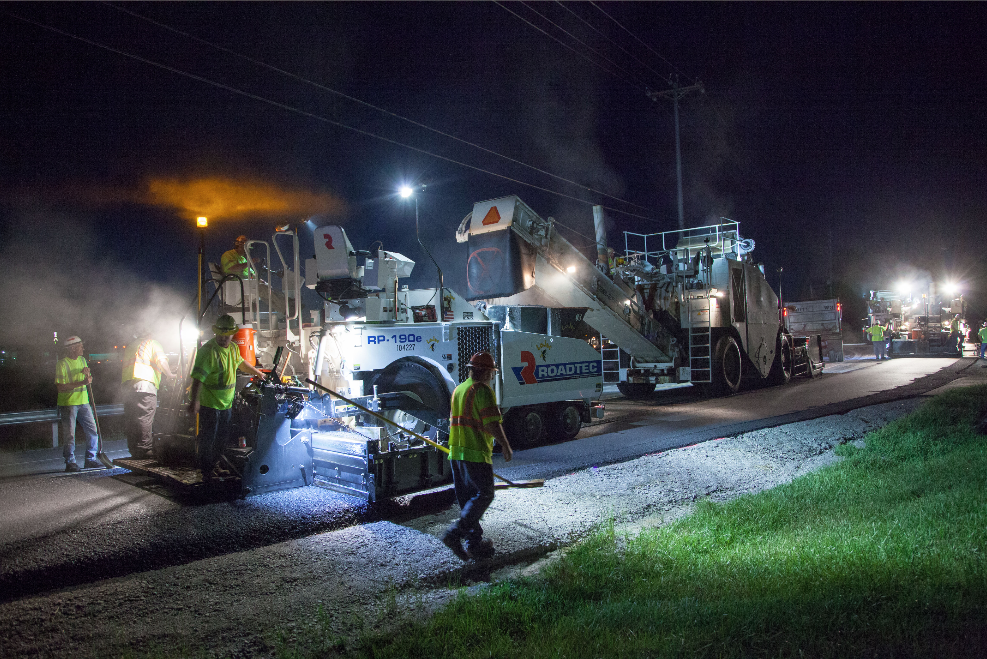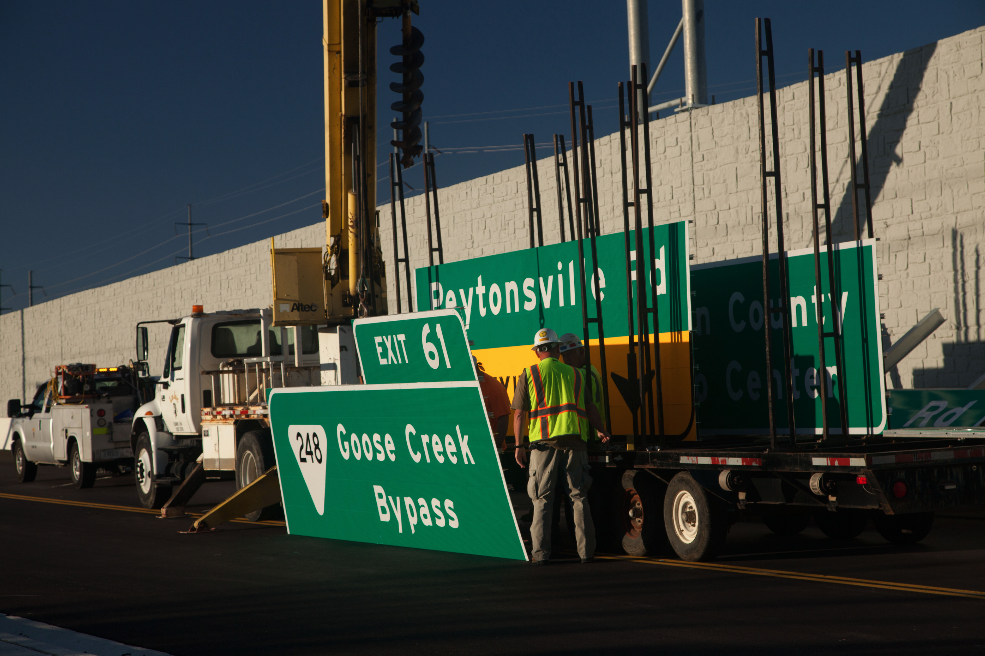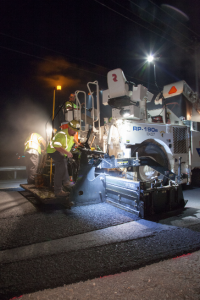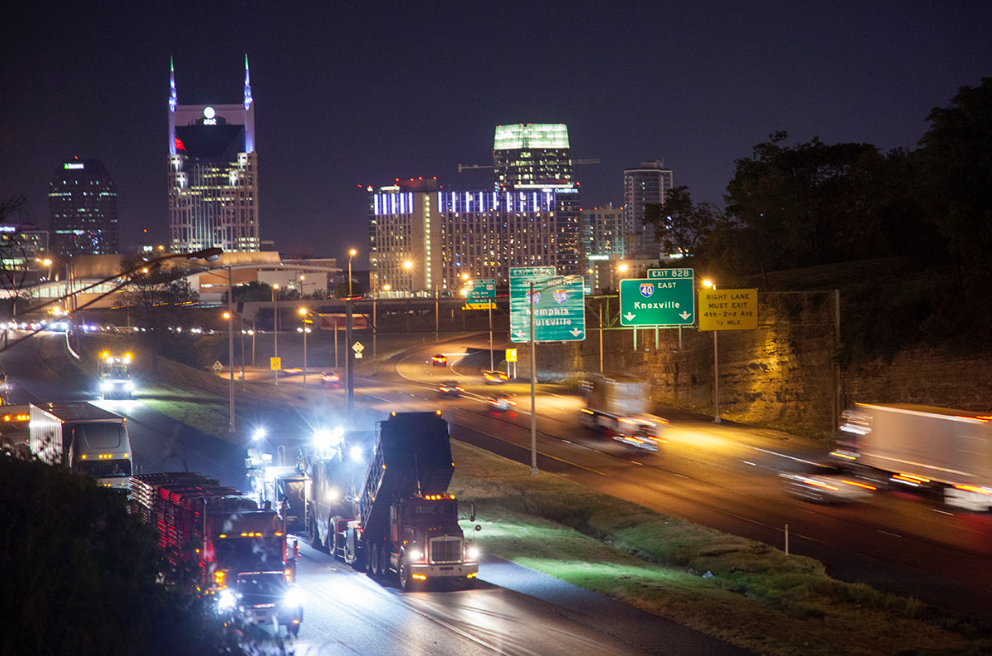LoJac Enterprises Commits to Quality, Overcomes the Unexpected
BY AsphaltPro Staff

Wrapping your head around the recently completed I-65/Goose Creek Bypass project in Franklin, Tennessee, is no small task. It was no small project.
The $46.1 million Tennessee Department of Transportation (TDOT) project included widening I-65, constructing a new interchange and widening State Route 248—also known as both Goose Creek Bypass and Peytonsville Road.
Despite the project’s complexities, the team at LoJac Enterprises, Lebanon, Tennessee, managed not only to complete the project on time—despite experiencing a major setback—but they also received a bonus for smoothness.
LoJac Enterprises won the bid for the job south of Nashville in Williamson County in fall of 2013 and completed the project in June of 2016. In total, the job required approximately 130,000 tons of asphalt and 170,000 tons of base stone to widen 3 miles of I-65—adding lanes both in the middle and outside of the existing pavement—as well as widen State Route 248 from a two-lane road to as many as five lanes at the interchange, going in both directions.
“This was one of the last heavy-duty exit ramps still relying on a two-lane bridge over I-65,” said Tim Murphy, construction manager for LoJac Enterprises. “Traffic would be backed up for miles on Goose Creek trying to get on the interstate.”
According to TDOT, on an average day, that portion of I-65 sees 70,000 vehicles—a number that is expected to increase to almost 125,000 within 15 years.
Recent developments in the area, like the 600-acre Berry Farms development, contributed to the increase in traffic along the bypass, and future developments are expected to increase daily traffic from 11,000 vehicles to 23,000 by 2033.

Much of LoJac’s crew grew up operating Roadtec equipment, Murphy said. Roadtec is located only 150 miles southeast of LoJac’s headquarters.
Overcome Challenges, Meet Deadlines
The first phase of the project was to add lanes in the middle of I-65 so they could transfer traffic to those new lanes. Then the crew could begin phase two, which required construction of the new exit ramps and begin widening Goose Creek Bypass.
It was during this phase that the project encountered a tragic and unexpected setback. On August 15, 2014, a tanker truck crashed into a pier of the old bridge and exploded. The driver, Bobby Bobo, lost his life in the crash. The heat from the fire was so severe that the beams of the new bridge were warped; the first phase of the new bridge would need to be torn down and entirely rebuilt.
“The first step was to do a lot of planning with TDOT,” Murphy said. Immediately following the accident, crews were already redirecting traffic up and down the ramps. “No one could drive under the bridge until the old structure was on the ground.”
The crew demolished the old bridge over the course of a weekend, repaired part of the road that had been damaged by the excessive heat and fuel spillage on Sunday, and then directed their attention to the new bridge.
Although the new bridge was still standing, the crew would need to tear it down and start over. That also required redirecting the efforts of the beam fabricator, who had already begun working on the beams for phase two. One month after the accident, the bridge was imploded. The crew cleaned up the wreckage over that weekend and began rebuilding the bridge Monday morning.
“[On the day of the accident,] the highway commissioner asked me if I thought we could open everything back up by Thanksgiving,” Murphy said. “We made a lot of phone calls, met with subcontractors, and were able to open phase one of the new bridge and put traffic across it the Tuesday before Thanksgiving.”
“It required a full team effort—from our crew, our sub contractors, our fabricators, everyone,” Murphy said. General Superintendent Kenny Black and Project Superintendent Luke Stinnett led clean-up efforts and Eric Brown, of Brown Builders, also led a major charge to clean up and complete the bridge on time. “It was a great accomplishment after a very sad situation.”
After overcoming the 100-day setback, the crew could continue with their original plans.
To fulfill TDOT’s project specifications, LoJac first had to complete massive grading, as well as utility relocation to replace storm sewers. Then the crew placed a 10-inch aggregate base using 307AS mix, at 270 pounds per square yard, to offer proper drainage. Then, the crew came back through with approximately 9 inches of 307A mix to build up the strength of the roadway, in three equal lifts. Next, they put down 2 inches of 307BM before putting down an open graded friction course of 1¼ inches, after TDOT changed the original surface mix to an open graded friction course.
“That mix in particular limits spray when it rains,” Murphy said. “It’s a really nice mix to lay. It’s a tough mix and it’s unforgiving for the crews, but it really worked well on this particular project.”

State Route 248 is also known as both Goose Creek Bypass and Peytonsville Road, depending on the direction of travel. Area developments are expected to increase daily traffic on this road from 11,000 vehicles to 23,000 by 2033.
LoJac Mills and Makes the Grade
To make the grade work, LoJac’s crew had to mill the existing roadway—a total of 12 lane miles. Depending on the grade, the crew paved the existing roadway with either 307A or 307BM mix, and then the surface mix.
In general, LoJac does almost all of its own milling—Murphy estimates around 100,000 tons per year. “It helps us mill right in front of the paving crew,” Murphy said. “Plus, the milling guys want to do a good, smooth job because the paving crew is on their team and they want to give them a good surface to operate on.”
Prior to 1995, LoJac sub contracted its milling work, but Murphy likes being in control “on both ends.”
“It helps us keep pace with the milling since we aren’t depending on anyone else’s schedule,” Murphy said. In Tennessee, if average daily traffic exceeds 70,000 on an interstate, the crew has to start paving within 72 hours of that surface being milled. For interstates with less traffic, they have up to 96 hours to begin. “With it being all our guys, we can time it really well.”

The RP-190e is a rubber-tired paver from Roadtec made for highway work. According to Murphy, 90 percent of LoJac Enterprises’ work is government-oriented paving, including airports, county, city and DOT work.
The final surface was completed entirely at night to allow for the necessary lane closures. “We had to maintain two lanes of traffic throughout the job at all times,” Murphy said, “but at night we could go down to one lane.”
According to Murphy, Rick Smith, who leads LoJac’s night paving operation team, relies heavily on night work. “He takes a lot of pride in night work and getting a lot more done with less traffic to deal with,” Murphy said. Smith also coordinates work operations with Paving Superintendent J.R. Hill.
To keep the crew safe during night jobs, lighting is key.
“We really light up all our Roadtec pavers, shuttle buggies, etc.,” Murphy said. The crew also wears safety vests and lit hard hats to stay visible. “We also have our own traffic control team with LoJac Safety looking out for us, as well as support from the State Highway Patrol.”
If the State Highway Patrol is busy, TDOT reimburses LoJac for the cost of hiring out the local law enforcement. In fact, LoJac’s safety committee has mandated that any nighttime paving on high-volume roads must have blue lights—police vehicles—on the scene before setting up any lane closures. They also operate Q attenuators trucks, where traffic is backing up.
To complete the job, LoJac relied on its Roadtec pavers, milling machines and shuttle buggies, as well as Caterpillar grading equipment, among others.
“LoJac gives us really good tools to work with: good pavers, good rollers, everything,” Murphy said. “All our crews on the paving side grew up running Roadtec equipment, because they’re local here,” Murphy said, adding that Roadtec is located only 150 miles southeast of LoJac’s headquarters. “Whatever the side of the machine says doesn’t matter as long as you have good equipment that doesn’t break down all the time.”

This fall, Lojac also completed a high-profile project in downtown Nashville. Lojac received a ride incentive based on smoothness of the $5 million, eight-lane mill and fill project.
Bonus-Worthy Results from LoJac
In the end, not only did LoJac complete the I-65 project on time, they also received a bonus for smoothness.
What made this project unique was that it incorporated three of four companies under the LoJac umbrella: LoJac Enterprises, which completed the grading, sub base and paving; LoJac Safety, which managed traffic; and LoJac Inc., which completed the ramp work. It was also the largest highway project LoJac has ever completed in-house.
“It was a company-wide effort,” Murphy said, “and an opportunity to put a bunch of mix on the ground in a high profile area of Franklin.”
Within the four companies, LoJac employs 425 people. LoJac Enterprises, specifically, has 200 employees, including three asphalt laydown crews of 10 employees each and two milling operation teams. According to Murphy, 90 percent of LoJac Enterprises’ work is government-oriented paving, including airports, county, city and DOT work.
At the time of Murphy’s interview, LoJac had just completed another high-profile job for TDOT, an eight-lane mill and fill with open graded friction course in downtown Nashville between mile marker 78 and 83. The $5 million, 36 lane mile project required 36,000 tons of asphalt and hit a 28 on TDOT’s smoothness test, resulting in a 6.5 percent ride incentive.
In addition to its grading and laydown services, LoJac Enterprises also operates 12 asphalt plants under the leadership of Plant Manager Bryan Carr, six of which are Astec plants, and produces mix both for its own projects and for other contractors.
LoJac started in 1983 when B.F. Jack Lowery and Don Chambers opened LoJac Incorporated and began offering concrete paving, repair and joint sealing. Within the year, the pair saw a need for LoJac Safety. A couple years later, Lowery and Chambers purchased MacDowell Materials’ paving division and a handful of asphalt plants to start LoJac Enterprises.
In the last couple of years, LoJac has transitioned to its second generation of leadership, led by J.D. Lowery, Glenn Chambers, Kellie Chambers Mires and Wendi Lowery Dalby.
With a continued focus on teamwork, safety and quality—and a steadfast commitment to deadlines—LoJac is sure to make successfully completing jobs from $5 million to $50 million look easy.
